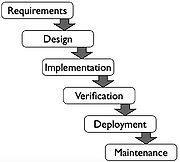Waterfall vs. Pull Processes
(→Waterfall Process) |
(→Waterfall Process) |
||
| Line 3: | Line 3: | ||
=Waterfall Process= | =Waterfall Process= | ||
The waterfall process... | The waterfall process... | ||
| − | [[File:Screen Shot 2018-02-25 at 18.17.11.jpg]] | + | [[File:Screen Shot 2018-02-25 at 18.17.11.jpg|thumb|The waterfall process]] |
==Pros== | ==Pros== | ||
==Cons== | ==Cons== | ||
Revision as of 17:28, 25 February 2018
There are many different methodologies of project management, all of them are defined by different principles and processes. A traditional, sequential methodology, is the Waterfall model. Within this model, the tasks of the project plan are sequenced and conducted in a linear way, one task must be completed before the next one begins - the process is smooth and continuous, like a waterfall. Therefore, this model is one of the simplest methods. However, the pull process-based methodologies are used to create the whole project plan more efficient and effective, it was created to eliminate confounding factors within the project, but it is more complex due to the consideration of many influences. This article provides an introduction to both methodologies, a comparison with pros and cons and a guidance how to select the right methodology for the practical usage.
Contents |
Importance for Project Management
Waterfall Process
The waterfall process...
